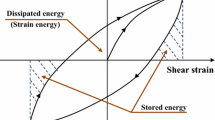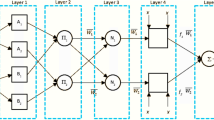Abstract
One of the most destructive phenomena occurring during earthquakes is liquefaction-induced lateral spreading. So far, various prediction models have been proposed focusing only on the accuracy of the lateral spreading estimations. However, the reliability of predictive models is also essential since the uncertainties of input parameters result in uncertain estimates. To assess the performance of such models under uncertainty, the values of governing parameters from a well-known database are first fuzzified. Then, the extreme amounts of the liquified soil displacement are computed via coupling the genetic algorithm with the prediction models. This is accomplished through solving optimization problems of many objectives for analysis of the uncertainty effects by the fuzzy sets theory. Considering the fuzzy statistical indices, it is found that the slightly uncertain inputs can drastically influence the responses. Moreover, since the recent model tree (MT)-based predictive model is revealed to be vulnerable against uncertainty, a novel model named MT (New model) was developed. It is concluded that both the accuracy and reliability of the proposed relationships compare favorably with other available models.












Similar content being viewed by others
References
Al Bawwab, W.E.M.K (2005) Probabilistic assessment of liquefaction-induced lateral ground deformations
Avval YJ, Derakhshani A (2019) New formulas for predicting liquefaction-induced lateral spreading: model tree approach. Bull Eng Geol Env 78:3649–3661
Bardet J-P, Tobita T, Mace N, Hu J (2002) Regional modeling of liquefaction-induced ground deformation. Earthq Spectra 18:19–46
Bardet J, Hu J, Tobita T, Mace N (1999) Database of case histories on liquefaction-induced ground deformation. A report to PEER/PG&E, Task 4
Bartlett SF, Youd TL (1992) Empirical prediction of lateral spread displacement. In: Technical Report NCEER, vol 1. vol 92–0019. US National Center for Earthquake Engineering Research (NCEER), pp 351–365
Bartlett SF, Youd TL (1995) Empirical prediction of liquefaction-induced lateral spread. J Geotech Eng 121:316–329
Baziar M, Ghorbani A (2005) Evaluation of lateral spreading using artificial neural networks. Soil Dyn Earthq Eng 25:1–9
Baziar M, Saeedi Azizkandi A (2013) Evaluation of lateral spreading utilizing artificial neural network and genetic programming. Int J Civ Eng 11:100–111
Branisavljevic N, Ivetic M (2006) Fuzzy Approach in the Uncertainty Analysis of the Water Distribution Network of Becej. Civ Eng Environ Syst 23:221–236
Derakhshani A (2017) Estimating uplift capacity of suction caissons in soft clay: A hybrid computational approach based on model tree and GP. Ocean Eng 146:1–8
Derakhshani A (2018) On the uncertainty analysis of uplift capacity of suction caissons in clay based on the fuzzy sets theory. Ocean Eng 170:416–425
Finn W, Ledbetter R, Wu G (1994) Liquefaction in silty soils: design and analysis. In: Ground failures under seismic conditions. ASCE, pp 51–76
Franke KW, Kramer SL (2014) Procedure for the empirical evaluation of lateral spread displacement hazard curves. J Geotech Geoenviron Eng 140:110–120
Goh AT, Zhang W (2014) An improvement to MLR model for predicting liquefaction-induced lateral spread using multivariate adaptive regression splines. Eng Geol 170:1–10
Gong W, Wang L, Khoshnevisan S, Juang CH, Huang H, Zhang J (2015) Robust geotechnical design of earth slopes using fuzzy sets. J Geotech Geoenviron Eng 141:04014084
Haghighi A, Asl AZ (2014) Uncertainty analysis of water supply networks using the fuzzy set theory and NSGA-II. Eng Appl Artif Intell 32:270–282
Haghighi A, Ayati AH (2016) Stability analysis of gravity dams under uncertainty using the fuzzy sets theory and a many-objective GA. J Intell Fuzzy Syst 30:1857–1868
Haghighi A, Keramat A (2012) A fuzzy approach for considering uncertainty in transient analysis of pipe networks. J Hydroinf 14:1024–1035
Hamada M, Towhata I, Yasuda S, Isoyama R (1987) Study on permanent ground displacement induced by seismic liquefaction. Comput Geotech 4:197–220
Holland JH (1992) Adaptation in natural and artificial systems: an introductory analysis with applications to biology, control, and artificial intelligence. MIT press,
Jafarian Y, Nasri E (2016) Evaluation of uncertainties in the available empirical models and probabilistic prediction of liquefaction induced lateral spreading. Amirkabir J Civ Environ Eng 48:275–290
Jafariavval Y, Derakhshani A (2020) New formulae for capacity energy-based assessment of liquefaction triggering. Mar Georesour Geotechnol 38:214–222. https://doi.org/10.1080/1064119X.2019.1566297
Jaimes MA, Niño M, Reinoso E (2015) Regional map of earthquake-induced liquefaction hazard using the lateral spreading displacement index D LL. Nat Hazards 77:1595–1618
Javadi AA, Rezania M, Nezhad MM (2006) Evaluation of liquefaction induced lateral displacements using genetic programming. Comput Geotech 33:222–233
Juang CH, Gong W, Martin JR, Chen Q (2018) Model selection in geological and geotechnical engineering in the face of uncertainty - Does a complex model always outperform a simple model? Eng Geol 242:184–196. https://doi.org/10.1016/j.enggeo.2018.05.022
Kalantary F, MolaAbasi H, Salahi M, Veiskarami M (2013) Prediction of liquefaction induced lateral displacements using robust optimization model. Sci Iran 20:242–250
Khorrami R, Derakhshani A (2019) Estimation of ultimate bearing capacity of shallow foundations resting on cohesionless soils using a new hybrid M5’-GP model. Geomech Eng 19:127–139
Khorrami, R., Derakhshani, A., & Moayedi, H. (2020). New explicit formulation for ultimate bearing capacity of shallow foundations on granular soil using M5’model tree. Measurement, 163, 108032.
Khoshroo R, Derakhshani A (2020) New formulation of reduction factors for pile groups under lateral loading through Model Tree technique. Ships and Offshore Struct 15:1120–1128. https://doi.org/10.1080/17445302.2019.1706884
Kuroki Y, Young GS, Haupt SE (2010) UAV navigation by an expert system for contaminant mapping with a genetic algorithm. Expert Syst Appl 37:4687–4697
Kutter BL, Gajan S, Manda KK, Balakrishnan A (2004) Effects of layer thickness and density on settlement and lateral spreading. J Geotech Geoenviron Eng 130:603–614
Montgomery J, Boulanger RW (2017) Effects of spatial variability on liquefaction-induced settlement and lateral spreading. J Geotech Geoenviron Eng 143:04016086
Newmark NM (1965) Effects of earthquakes on dams and embankments. Geotechnique 15:139–160
Olson SM, Johnson CI (2008) Analyzing liquefaction-induced lateral spreads using strength ratios. J Geotech Geoenviron Eng 134:1035–1049
Pal M, Deswal S (2009) M5 model tree based modelling of reference evapotranspiration. Hydro Process Int J 23:1437–1443
Quinlan JR (1992) Learning with continuous classes. 5th Australian joint conference on artificial intelligence. World Scientific, pp 343–348
Rahbarzare A, Azadi M (2019) Improving prediction of soil liquefaction using hybrid optimization algorithms and a fuzzy support vector machine. Bull Eng Geol Env 78:4977–4987. https://doi.org/10.1007/s10064-018-01445-3
Rauch AF, Martin JR III (2000) EPOLLS model for predicting average displacements on lateral spreads. J Geotech Geoenviron Eng 126:360–371
Razifard M, Shoaei G, Zare M (2019) Application of fuzzy logic in the preparation of hazard maps of landslides triggered by the twin Ahar-Varzeghan earthquakes (2012). Bull Eng Geol Env 78:223–245. https://doi.org/10.1007/s10064-018-1235-4
Rezania M, Faramarzi A, Javadi AA (2011) An evolutionary based approach for assessment of earthquake-induced soil liquefaction and lateral displacement. Eng Appl Artif Intell 24:142–153
Sharp MK, Dobry R, Abdoun T (2003) Liquefaction centrifuge modeling of sands of different permeability. J Geotech Geoenviron Eng 129:1083–1091
Talebi A, Derakhshani A (2019) Estimation of P-multipliers for laterally loaded pile groups in clay and sand. Ships and Offshore Struct 14:229–237
Tokida K, Matsumoto H, Azuma T, Towhata I (1970) Simplified procedure to estimate lateral ground flow by soil liquefaction. WIT Transactions on The Built Environment 3
Towhata I, Sasaki Y, Tokida K-I, Matsumoto H, Tamar Y, Yamada K (1992) Prediction of permanent displacement of liquefied ground by means of minimum energy principle. Soils Found 32:97–116
Wang J, Rahman M (1999) A neural network model for liquefaction-induced horizontal ground displacement. Soil Dyn Earthq Eng 18:555–568
Witten I, Wang Y (1997) Induction of model trees for predicting continuous classes. In: Proc. Poster Papers Europ. Conf. Machine Learning
Yasuda S, Nagase H, Kiku H, Uchida Y (1992) The mechanism and a simplified procedure for the analysis of permanent ground displacement due to liquefaction. Soils Found 32:149–160
Youd TL, Hansen CM, Bartlett SF (2002) Revised multilinear regression equations for prediction of lateral spread displacement. J Geotech Geoenviron Eng 128:1007–1017
Youd TL, Perkins DM (1987) Mapping of liquefaction severity index. J Geotech Eng 113:1374–1392
Author information
Authors and Affiliations
Corresponding author
Rights and permissions
About this article
Cite this article
Ghasemi Rozveh, S., Derakhshani, A. Uncertainty analysis of liquefaction-induced lateral spreading using fuzzy variables and genetic algorithm. Bull Eng Geol Environ 80, 9185–9200 (2021). https://doi.org/10.1007/s10064-021-02385-1
Received:
Accepted:
Published:
Issue Date:
DOI: https://doi.org/10.1007/s10064-021-02385-1




